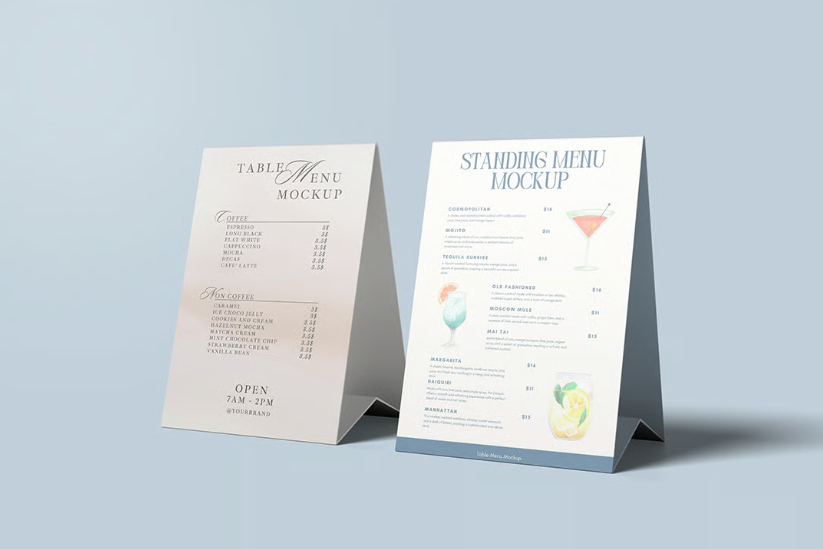Today’s business card design is more than just contact details; it’s an opportunity to connect both offline and online. Including social media icons on your business card helps bridge that gap, turning a simple card into a powerful networking tool.
Below, we’ll explain why adding social media icons to your business card is important in networking and show you how to choose the right platforms to include.
From picking the best icons to design tips, you’ll learn how to make your business card more effective and suited for modern professional communication.
Why Include Social Media on Your Business Cards
Social media icons act as a simple but powerful way to connect your offline and online presence. When someone receives your card, whether after a meeting or at a trade show, these familiar icons encourage them to look you up, follow your brand, or reach out online.
It’s a smart, easy way to keep the conversation going and build stronger connections beyond the first meeting.
- Extend Your Reach: Connect offline interactions with your online presence to stay top of mind after the first meeting.
- Build Credibility: Give prospects an easy way to learn more about your brand, view past work, and verify your reputation.
- Encourage Engagement: Make it simple for people to follow, message, or tag you on platforms they already use. Social media also enables customers to ask questions, provide feedback, and interact with your business in real time, improving customer support and brand experience.
- Save on Marketing Costs: Social media follow ups are free, offering a high return for a minimal investment.
- Boost Brand Recall: Recognizable icons and usernames help people remember your business and engage on their terms.
- Create Long-Term Value: One social follow can lead to ongoing exposure through organic posts and future campaigns.
Which Social Media Platforms to Include
The platforms you showcase should align with your business goals, industry, and audience. To make the most significant impact, highlight the channels where your audience is most active, and where your brand maintains a consistent, professional presence.
Be sure to include only the platforms you actively update and check regularly, so potential clients can trust that their messages and interactions will be seen. Focus on quality over quantity to ensure meaningful, ongoing engagement.
LinkedIn is the go to platform for B2B professionals, consultants, and anyone looking to connect with corporate decision makers. Including your custom LinkedIn URL or handle on your business card instantly communicates professionalism and positions your brand within a network driven space.
With over 61 million senior level influencers on LinkedIn, it’s one of the most effective ways to build credibility and foster meaningful business connections. If you’re in a professional services field, this platform is a must have.
Instagram:
Including the Instagram logo for your business card is ideal for visually driven brands, such as restaurants, design studios, lifestyle businesses, and creative professionals. It signals a portfolio style presence, showing customers that you prioritize strong visual storytelling and creative presentation.
With over 2 billion monthly active users, Instagram is the third most popular social media platform in the world, making it a valuable channel for visibility and connection. Its strong focus on visual content and interaction makes it especially effective for businesses where appearance heavily influences customer decisions.
It's also important that your Instagram handle is clear and easy to read, helping recipients engage with you quickly and without confusion.
Adding the Facebook logo to your business card works especially well for local services, event promotion, and businesses that thrive on community engagement. It signals that you’re accessible and responsive, two key factors for service-based businesses that depend on word-of mouth, customer reviews, and ongoing interaction.
Facebook also helps reinforce trust by giving potential customers an easy way to see ratings, updates, and how you interact with your audience.
Keep In Mind: One of the key things to consider is how your Facebook presence showcases customer reviews, ratings, and engagement.
X (Formerly Known as Twitter)
It’s ideal for those who prioritize real time updates, thought leadership, or responsive customer service. Its fast paced, conversational format is particularly effective for industries like news, technology, or public commentary, where timely communication and active engagement can set you apart from the competition.
Adding the X logo and handle on your business card shows you’re tuned in and ready to connect in the moment. X is also a great platform to announce a new product drop or special event, helping to generate buzz and engagement.
TikTok
TikTok has become a powerful platform for reaching younger audiences, with approximately 1.5 to 1.9 billion monthly active users worldwide. It’s especially well suited for creative professionals, influencers, eCommerce brands, and industries like entertainment, beauty, and food. Including the TikTok logo and handle on your business card signals a trend aware, visually engaging presence, ideal for those leveraging short-form video to increase visibility and connect with digitally native consumers.
Including the TikTok logo and handle on your business card signals a trend savvy, visually engaging approach that resonates with Gen Z and digitally native consumers. It reflects a modern and dynamic presence, great for those leveraging short form video to drive visibility and engagement.
Did You Know: TikTok is also an effective platform for promoting new merchandise and limited time offers to a highly engaged audience.
YouTube
YouTube is a strong addition for professionals and companies that share tutorials, product demos, educational content, or thought leadership videos. Including the YouTube icon on your business card signals a commitment to transparency and value driven content.
Clients and customers who prefer visual learning appreciate this approach, as it offers a deeper understanding of your expertise, services, or solutions before making a decision.
Strategic Platform Selection
To keep your business card clean and effective, it’s best to limit the number of social media icons to three or four. This helps avoid visual clutter and keeps your message focused. When deciding which platforms to include, prioritize those where you’re actively posting and where your audience is most engaged. Outdated or inactive accounts can leave a poor impression and may hurt your credibility.
For even better results, consider tailoring your business cards for specific events or audiences. For example, a card for a tech conference might highlight LinkedIn and X (formerly Twitter), while one for a design expo could feature Instagram and TikTok. Understanding your audience is often the best way to match your social presence and helps you make more meaningful, relevant connections.
Brand Guidelines and Legal Compliance
Each social platform enforces strict brand guidelines for icon usage, backed by trademark law and platform policy. Understanding and following these requirements protects your business from legal issues while maintaining the professional appearance that enhances credibility.
Always download official social media icons directly from the platforms' websites to ensure compliance, high quality, and to avoid copyright issues.
Platform-Specific Requirements
- Facebook: Only the official “f” logo is permitted never the full wordmark or customized versions. It must be used in Facebook’s signature blue or white, with the correct shape, spacing, and no animations or alterations.
- Instagram: When considering logo usage, the camera icon must retain its original proportions and structure. Solid color versions are allowed, as long as the overall design remains consistent and recognizable.
- LinkedIn: Approved colors include blue, black, or white, with a minimum print size of 0.25 inches (6.35mm) to ensure legibility. Modifications such as stretching, rotating, or recoloring are not allowed to preserve the platform’s professional image.
- Twitter: Use only the official logo in blue or white. Black may be used with prior approval. Any changes to color, shape, or design are prohibited to maintain brand clarity and prevent confusion.
Licensing and Legal Considerations
When using social media icons on your business card, be sure to check licensing terms. Free icon sets may require attribution or have usage limits, while paid versions typically include commercial rights.
Avoid using icons from questionable sources or those marked with watermarks they may not be legally cleared for print and can look pixelated. To protect your business and ensure a professional finish, always use high quality, properly licensed icons.
Conclusion: Make Every Connection Count
In today’s digitally connected world, your business card should do more than list your name and phone number it should open the door to continued engagement. Adding social media icons is a smart, modern way to extend conversations, provide access to showcase your credibility, and make it easier for people to stay in touch long after the first handshake.
By choosing the right social media platforms, following brand guidelines, and using properly licensed icons, you ensure your card looks polished, professional, and purposeful, as part of a well thought out collection of networking tools.
Whether you’re at a networking event, conference, or casual meeting, a thoughtfully designed card with the right social media links helps you stand out and stay connected.
social-media-icons-on-business-cards



